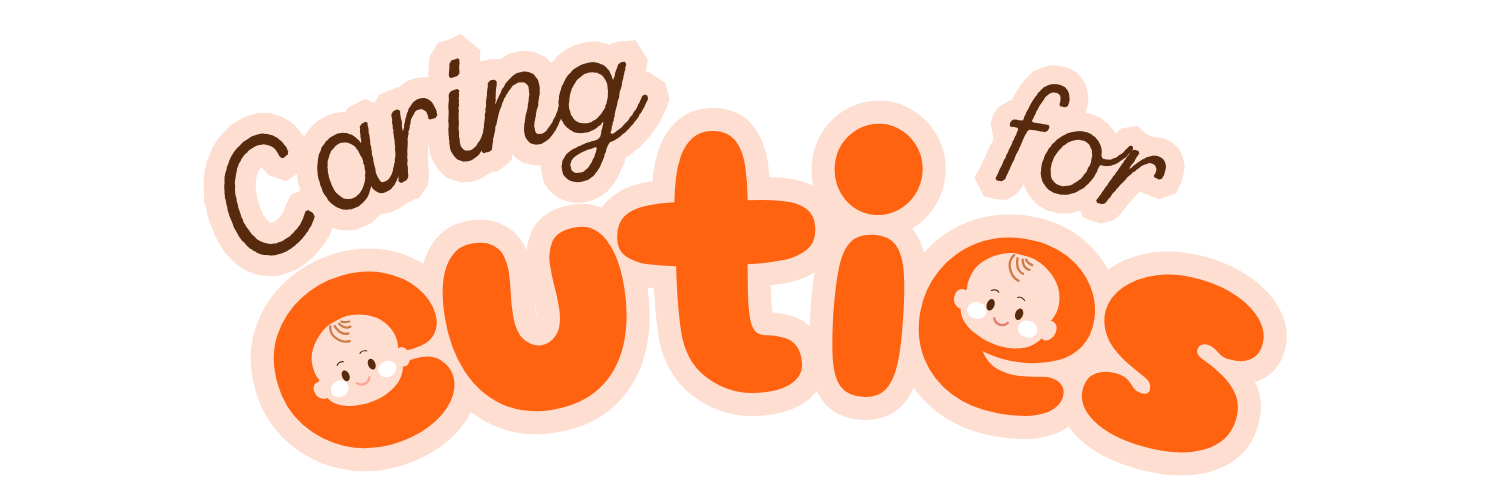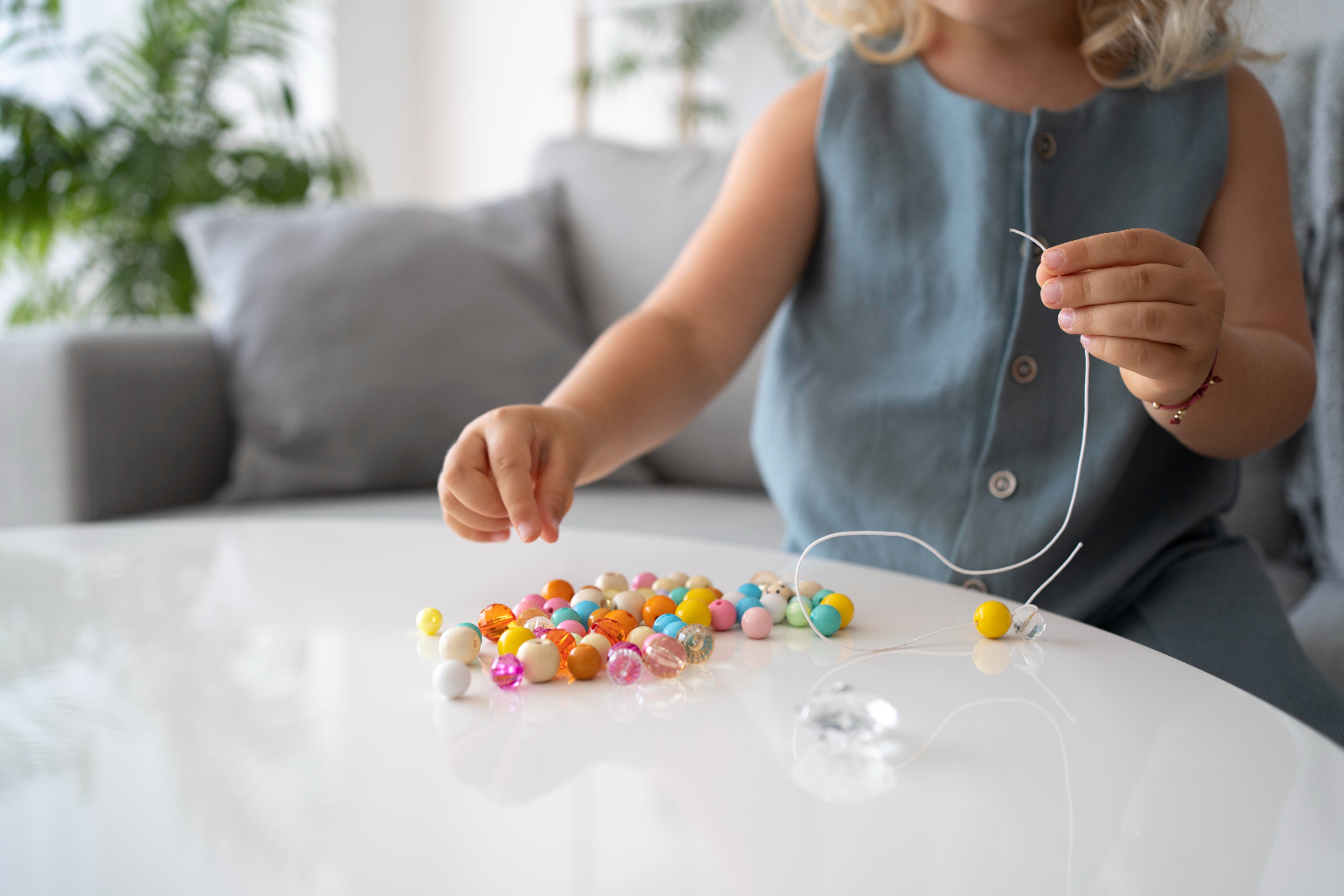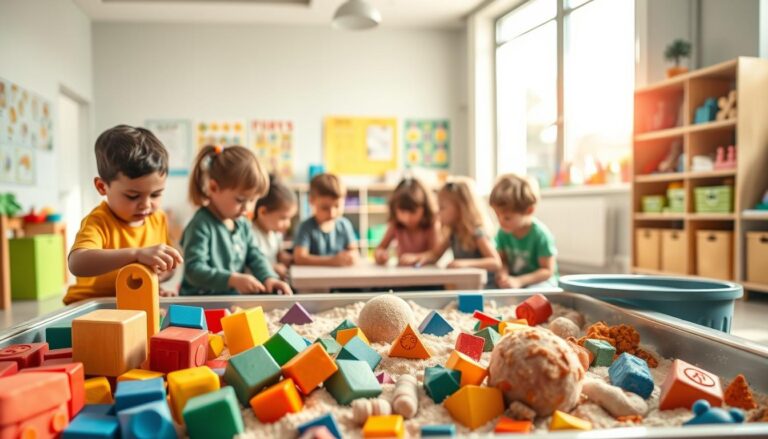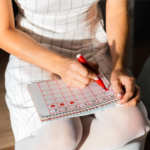As parents and educators, we know how vital fine motor skills are in early childhood. These skills, which involve hand and finger movements, are key for a child’s future success. But how can we help our preschoolers develop these skills? What are the best strategies and activities to help them reach their full ability?
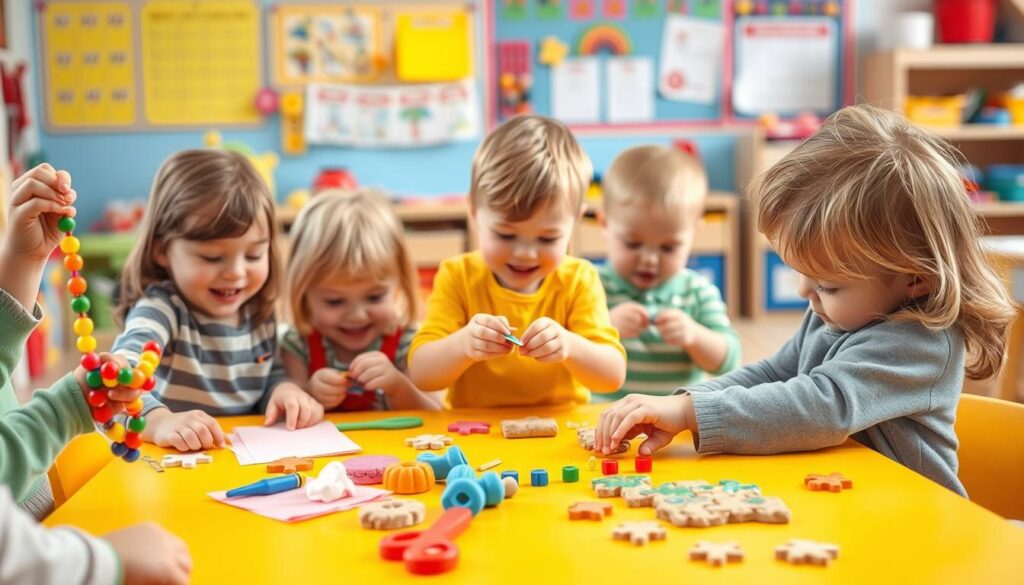
Key Takeaways
- Fine motor skills are essential for a child’s growth in many areas.
- Doing different activities that match their age can really help improve their dexterity and coordination.
- Making fine motor practice a part of daily life and play can make it fun and easy.
- Keeping an eye on how they’re doing and tackling any problems early on is important for their growth.
- Working together with parents, teachers, and healthcare professionals can greatly help in developing fine motor skills.
Understanding Fine Motor Skills Development in Early Childhood
Fine motor skills involve using small muscles in hands, fingers, and wrists for precise movements. As preschoolers grow, they hit milestones in fine motor skills. Knowing these milestones helps parents and teachers support their development.
Key Developmental Milestones
By 3, kids can handle small objects like blocks with their fingers. They can also grasp pencils and crayons and turn book pages. By 4, they should cut paper with scissors, string beads, and draw simple shapes.
As they turn 5, kids show more advanced skills. They can tie shoelaces, button clothes, and draw recognizable figures.
The Brain-Hand Connection
Fine motor skills grow with the brain. As the brain matures, the connection between it and the hands gets better. This connection is key for skills like handwriting, self-care, and creativity.
Age-Appropriate Expectations
It’s vital to have realistic expectations for preschoolers’ fine motor skills. Some kids may learn faster, while others may take more time. Focus on providing the right activities and celebrating each child’s progress.
Understanding the fine motor skills timeline, the brain-hand connection, and age-appropriate expectations helps create a supportive environment. This environment fosters the growth of these essential skills in preschoolers.
Essential Tools and Materials for Fine Motor Skills Practice
Helping preschoolers develop fine motor skills is fun with the right tools and materials. While fine motor skills toys for preschoolers are great, everyday items can also help. Mixing toys with household items makes learning fun and engaging.
The best toys for fine motor skills development include puzzles, beads, and lacing cards. Also, pegboards, shape sorters, and play dough are excellent. Household items like clothespins, tongs, tweezers, and small containers are also great for fine motor skills activities with household items.
- Puzzles: Encourage problem-solving and hand-eye coordination as children manipulate puzzle pieces.
- Beads and Lacing Cards: Strengthen finger muscles and dexterity through the act of threading and stringing.
- Pegboards: Promote fine motor skills and hand-eye coordination as children grasp and place pegs.
- Shape Sorters: Challenge children to match and manipulate various shapes, improving precision.
- Play Dough: Kneading, rolling, and sculpting play dough helps build hand strength and dexterity.
Offering a variety of toys and household items creates a great learning environment. This way, preschoolers can improve their hand-eye coordination, finger strength, and dexterity. It prepares them for success in school and everyday life.
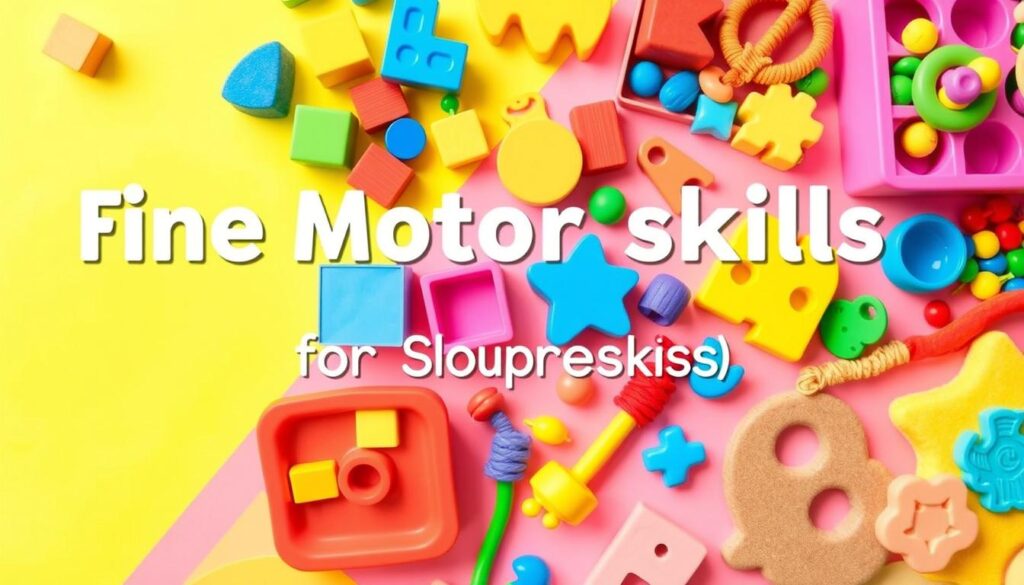
Preschoolers Fine Motor Skills: Activities and Exercises
Engaging preschoolers in various activities can boost their fine motor skills. These activities fall into three main categories: daily life tasks, structured play, and creative art projects.
Daily Life Activities
Tasks like buttoning, zipping, and using utensils help preschoolers improve their fine motor skills. Encourage them to practice these skills during daily routines. Offer guidance and praise as they get better at coordination and dexterity.
Structured Play Activities
Activities like puzzles, sorting games, and building blocks challenge preschoolers’ fine motor skills in a fun way. These tasks require children to handle small objects, boosting their hand-eye coordination and hand strength.
| Activity | Benefit |
|---|---|
| Puzzles | Improves hand-eye coordination and problem-solving skills |
| Bead stringing | Enhances finger dexterity and hand-eye coordination |
| Lego and block building | Develops manual dexterity and spatial awareness |
Creative Art Projects
Engaging preschoolers in creative art projects like drawing and cutting can greatly improve their fine motor skills. These activities require children to handle small tools and materials. This promotes hand strength and precision.
- Drawing and coloring exercises
- Cutting and pasting activities
- Modeling and sculpting with playdough or clay
By adding these activities to a preschooler’s daily routine, parents and educators can help develop their fine motor skills. This lays a strong foundation for future success in academics and personal life.
Building Hand Strength Through Sensory Play
It’s key for preschoolers to have strong hands and fine motor skills. Sensory play, like playdough and other hands-on activities, is a great way to help.
Sensory play boosts hand strength and hand-eye coordination. These skills are vital for writing, cutting, and handling objects. By playing with play dough, kids can get the hand strength and dexterity they need.
- Encourage children to knead, roll, squeeze, and shape the playdough using their hands, fingers, and palms.
- Provide tools like rolling pins, cookie cutters, and sculpting tools to add variety and challenge to the play experience.
- Experiment with different textures and consistencies of play dough, such as adding glitter, beads, or even essential oils for a more sensory-rich experience.
Other sensory play activities, like finger painting and clay modeling, also help. Working with materials like sand, rice, or dried beans is great too. These activities not only build hand strength but also spark creativity and problem-solving.
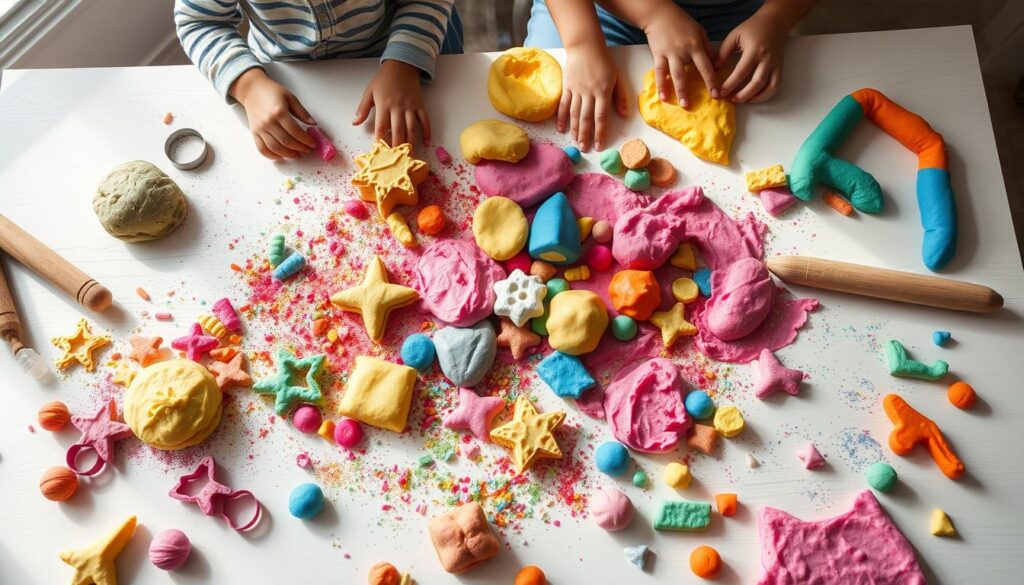
Adding activities to strengthen hand-eye coordination to your child’s day can really help. It supports their fine motor skills and prepares them for school and life.
Art and Craft Activities to Enhance Dexterity
It’s key to help preschoolers grow their fine motor skills. Art and craft activities are great for this. They can do things like drawing, coloring, cutting, pasting, and sculpting. These activities boost dexterity and hand-eye coordination.
Drawing and Coloring Exercises
Drawing and coloring are excellent for scissor skills, hand strength, and precision. Encourage kids to try different tools like crayons, markers, and colored pencils. They can color simple shapes or draw their own pictures. These activities improve fine motor skills and spark creativity.
Cutting and Pasting Projects
Cutting and pasting are great for scissor skills and hand-eye coordination. Use children’s scissors and thick paper for cutting practice. Kids can cut shapes and patterns. Then, they can paste things together to make collages or cards.
Modeling and Sculpting Activities
Modeling and sculpting are very helpful for preschoolers. Give them clay or playdough to shape and mold. These activities improve dexterity and encourage imagination and problem-solving.
Adding art and craft to a preschooler’s day helps them grow. It’s fun and helps with drawing, cutting, and pasting. These creative fine motor skills crafts for kids are a great way to support their development.
Incorporating Fine Motor Skills in Daily Routines
Teaching preschoolers fine motor skills doesn’t have to be just for playtime. You can also add these skills to daily routines. Tasks like brushing teeth and using silverware can help. Even simple actions like buttoning clothes and folding laundry are great for their development.
Personal care routines are a great place to start. Let your child brush their teeth, helping them hold the toothbrush and move it carefully. Using silverware at meals also improves their grip and coordination.
- Dressing and undressing, like buttoning clothes and folding clothes, work on their fine motor skills. They practice with small fasteners and finger coordination.
- Help your child with chores that need fine motor skills, like sorting socks or organizing small items.
- Set up a play area with fine motor skills activities at home. Things like pegboards, lacing cards, or building blocks are great for independent learning and skill building.
By adding fine motor practice to your child’s daily life, you help them grow. This prepares them for school and future success.
| Fine Motor Skill | Daily Routine Activity |
|---|---|
| Brushing teeth | Grasping toothbrush, making small, controlled movements |
| Using silverware | Developing pincer grip, hand-eye coordination |
| Buttoning clothes | Manipulating small fasteners, coordinating fingers |
| Folding clothes | Developing dexterity, spatial awareness |
| Fine motor skills activities at home | Exploring pegboards, lacing cards, building blocks |
By adding fine motor skill practice to your child’s daily routine, you help them grow. This prepares them for school and future success.
Games and Activities for Hand-Eye Coordination
Hand-eye coordination is key for fine motor skills in preschoolers. Playing games and doing activities that challenge this skill helps a lot. It boosts their dexterity and ability to use their hands well.
Beading and Threading Activities
Beading and threading are great for improving hand-eye coordination. Give preschoolers colorful beads, strings, or shoelaces. Ask them to make patterns, necklaces, or simple jewelry. It helps their vision, hand skills, and problem-solving.
Sorting and Matching Games
Sorting and matching games, like button sorting or using Lego blocks and other building blocks, are perfect. They help kids see, grab, and move small things with care. It also sharpens their thinking.
Building and Construction Play
Encourage kids to play with building and construction play using Lego blocks or other building blocks. It’s a fun way to improve hand-eye coordination. It also boosts creativity, problem-solving, and understanding of space.
Adding these fun activities to your preschooler’s day helps a lot. It improves their hand-eye coordination and sets a good base for fine motor skills.
Monitoring Progress and Addressing Challenges
It’s important to keep an eye on a child’s preschool fine motor skills growth. This helps make sure they’re doing well. Parents and teachers can spot any signs of fine motor skills delays in preschoolers and start fine motor skills improvement strategies to help them.
A simple preschool fine motor skills checklist is a great way to track a child’s progress. It should list important skills like holding small objects, using scissors, and writing with utensils. Checking this list often helps find where a child might need extra help.
If a child shows signs of fine motor skills delays in preschoolers, it’s vital to work with teachers and doctors. Together, you can create a plan to improve their skills. This might include occupational therapy, special activities, and focused exercises to boost their hand-eye coordination and dexterity.
“Patience and persistence are key when addressing fine motor skill challenges in preschoolers. With the right support and guidance, these skills can be developed and refined over time.”
Every child grows at their own speed, and it’s key to celebrate their small wins. By paying attention to their needs and using the right fine motor skills improvement strategies, you can help preschoolers overcome any hurdles and excel in their fine motor skill development.
Conclusion
Developing fine motor skills in preschoolers is key to their growth and readiness for school. These skills help kids do everyday tasks and prepare them for more complex learning. They are essential for problem-solving and academic success.
Parents and teachers are important in helping kids develop these skills. By giving them activities that match their age, we encourage their growth. We also help them build dexterity and hand-eye coordination through daily practice.
Every child develops at their own speed, but with support, they can do great things. With patience and the right activities, we help our preschoolers reach their goals. They will be ready to start their educational journey with confidence.
FAQ
What are fine motor skills, and why are they important for preschoolers?
Fine motor skills are the small, precise hand movements. They help with writing, buttoning, and using utensils. These skills are key for school and self-care later on.
What are the key developmental milestones for fine motor skills in preschoolers?
Kids start with simple hand movements and grow to use scissors and small items. Each step is a milestone. Expectations help parents and teachers guide them.
What are some essential tools and materials for practicing fine motor skills?
Tools like puzzles, beads, and crayons are great. Even household items like clothespins help. They make learning fun and engaging.
What types of activities can help develop fine motor skills in preschoolers?
Many activities help, from daily tasks to creative projects. The goal is to keep it fun and right for their age.
How can sensory play contribute to fine motor skills development?
Sensory play, like with playdough, strengthens hands. It’s a hands-on way to improve fine motor skills and coordination.
What art and craft activities can enhance dexterity in preschoolers?
Drawing, cutting, and sculpting improve fine motor skills. These activities are great for building dexterity and hand-eye coordination.
How can fine motor skills be incorporated into daily routines?
Daily tasks like brushing teeth and using utensils are good practice. Getting kids involved helps improve their skills.
What games and activities can target hand-eye coordination?
Games like beading and building are perfect. They help kids improve their fine motor skills and visual awareness.
How can parents and educators monitor progress and address challenges in fine motor skills development?
Watch for progress and use checklists. If there’s a delay, try targeted activities and seek help. This ensures kids get the support they need.
